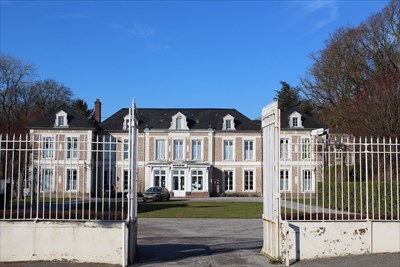[EN] If the building was partly built in the 17th century, when the estate became part of the Monchy family, it was mainly in the 19th century that the castle underwent most of its modifications. Made of both bricks and stones, the walls of the building testify to these many changes.
According to the map of the Routes of Flanders, about 1747, the castle had a remarkable park, of a particularly careful and regular composition. A long perspective extends the courtyard. A structure that is still visible today
In 1823, a fire ravaged the castle. The reconstruction is led by the Valanglart. It is from this era that the following landscaping would date:
- an oval shaped parterre is created in the courtyard.
- on the left, a grove with wooded massifs separated by a maze of small walkways, which form a kind of labyrinth. Creating an original transition to the vegetable garden.
- in the north-west, an irregular park is drawn around a large central lawn.
It is in the Age of Enlightenment that we find a descendant of the illustrious family: François de Monchy. He usually resided in Sailly and his daughter (Abbess of Avesne) also regularly came to the castle to rest.
On the death of the latter in 1715 until 1758 the castle remained uninhabited.
At that date, it was his second grandson, André, captain of cavalry, who decided to buy the house from his brother. And it is quite naturally that he inherited the title of Marquis de Monchy at the death of his elder.
After the death of André in 1782, his widow Hortense le Roy remarried a year later with Charles-Marie, Marquis of Essars (captain of the Dragons and nephew of his first husband).
But in 1791, the revolutionary context which agitated France prompted the Marquis and the Marquise to emigrate first to Holland and then to England.
Some time after their arrival, Hortense des Essars decided to return to France, in order to avoid the confiscation of her property, leaving her husband to his activities.
Continuing to suffer the throes of the new regime, the Marchioness finds herself incarcerated in March 1793 and will not be released until October 1794. Upon her exit she discovers her castle completely looted and emptied of its effects. During his absence, the adjudication of his property would have yielded no less than 64,475 pounds. When horses, sheets and mattresses were requisitioned by military authority.
At the beginning of the 20th century, the castle found itself in the possession of Eusébe Hecquet de Beaufort, who died there in 1926.
Then, René Stremler, industrialist of Sailly acquired the castle around 1926; His four children: Jean-Pierre, Elisabeth, Odile and Catherine inherited it at his death on May 10, 1944, and then sold it in 1976 to the commune of Sailly-Flibeaucourt.
Today the building houses the Town Hall of Sailly-Flibeaucourt.

[ FR] Si l'édifice remontait partiellement au XVIIe siècle, date à laquelle le domaine entre dans la famille de Monchy, c'est principalement au XIXe siècle, que le château subit la plupart de ses modifications. Fait à la fois de briques et de pierres, les murs de l'édifice attestent de ces nombreux remaniements.
D'après la carte des Routes de Flandres, vers 1747, le château possédait un parc remarquable, d'une composition particulièrement soignée et régulière. Une longue perspective prolonge la cour d'honneur. Une structure qui est encore visible aujourd'hui
En 1823, un incendie ravage le château. La reconstruction est menée par les Valanglart. C'est de cette époque que daterait l'aménagement paysager suivant :
- un parterre de forme ovale est crée dans la cour.
- sur la gauche, un bosquet avec des massifs boisés séparés par un dédale de petites allées, qui forment une sorte de labyrinthe. Créant de manière originale une transition vers le jardin potager.
- au Nord-Ouest, un parc irrégulier est dessiné autour d'une vaste pelouse centrale.
C'est au siècle des Lumières que l'on retrouve un descendant de l'illustre famille: François de Monchy. Il résidait habituellement à Sailly et sa fille (abbesse d'Avesne) venait également régulièrement au château se reposer.
A la mort de ce dernier en 1715 jusqu'en 1758 le château demeura inhabité.
A cette date, c'est son second petit fils, André, capitaine de cavalerie, qui décida de racheter la demeure à son frère. Et c'est tout naturellement qu'il hérita du titre de Marquis de Monchy à la mort de son ainé.
Après le décès d'André en 1782, sa veuve Hortense le Roy, se remarie un an plus tard avec Charles-Marie, Marquis des Essars (capitaine des Dragons et neveu de son premier mari).
Mais en 1791, le contexte révolutionnaire qui agite la France pousse le Marquis et la Marquise à émigrer d'abord vers la Hollande puis en Angleterre.
Quelques temps après leur arrivée, Hortense des Essars se décida à regagner la France, afin d'éviter la confiscation de ses biens, laissant ainsi son mari à ses activités.
Continuant de subir les affres du nouveau régime, la Marquise se retrouve incarcérée en mars 1793 et ne sera libérée qu'en octobre 1794. A sa sortie elle découvre son château entièrement pillé et vidé de ses effets. Pendant son absence, l'adjudication de ses biens aurait rapporté pas moins de 64 475 livres. Quand aux chevaux, aux draps et aux matelas, ils furent réquisitionnés par l'autorité militaire.
Au début de XXe siècle, le château se retrouve en la possession de Eusébe Hecquet de Beaufort, qui y meurt en 1926.
C'est ensuite, René Stremler, industriel de Sailly qui a acquis le château vers 1926; ses quatre enfants : Jean-Pierre, Elisabeth, Odile et Catherine en ont hérité à sa mort le 10 mai 1944, puis l'ont vendus en 1976 à la commune de Sailly-Flibeaucourt.
Aujourd'hui le bâtiment abrite la Mairie de Sailly-Flibeaucourt.
Sources : Histoire & découvertes